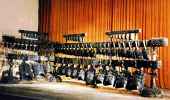| How did the traditional Chinese Music develop? In the Xia, Shang and Zhou Dynasties, only royal families and dignitary officials enjoyed music. Instruments such as stone chimes, bronze bells, panpipes, and the Sheng were widely used at that time. The Chinese, especially the rulers, have always believed that the beautiful melodies of music are good for harmony of the universe. During the Han Dynasty
| 
|
, the imperial court had set up a Music bureau in charge of gathering and editing ancient tunes and folk songs.With the rapid development of China’s international trade, especially with Central Asia, foreign music was brought to the country in the form of the Pipa and the Huqin, a vertically held violin. The foreign originating music had such a big effect on our composers of this time that they modified and improved Chinese music to a huge extent. By the time of the Tang Dynasty, dancing and singing were added into the art form. And everyday people enjoyed the pleasure of music. During the tenure of the Emperor Tang Xuanzong, the court organized the Pear Garden Academy song and dance troupe which developed a large number of musicians and laid a firm foundation for Chinese music. With foreign religions such as Buddhism and Islam coming into China, exotic and religious melodies were absorbed into Chinese music. Since the Song Dynasty, original opera started to be performed for the public. And it was quite popular among the common people. In the Yuan Dynasty, there was a new type of literature – Qu. It showed a good combination of literature and music. When it came to Ming and Qing Period, the art of opera developed further and the most famous Beijng-Opera was created. |